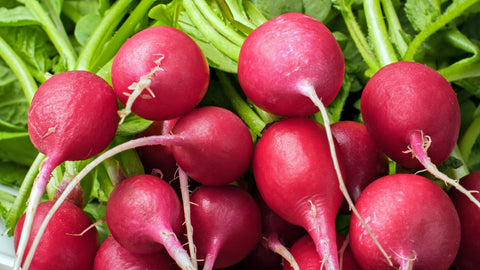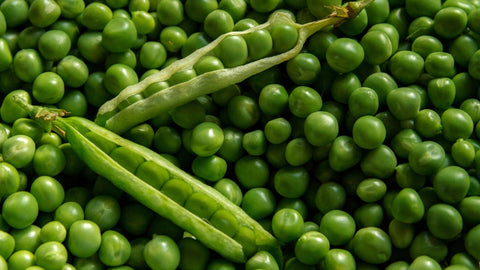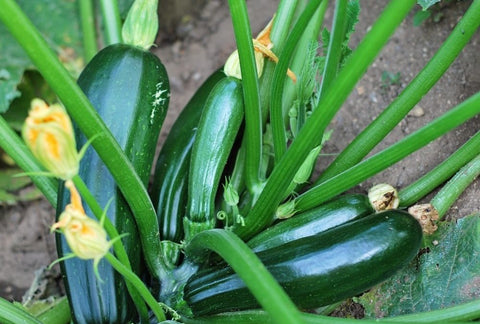Radishes are one of the quickest and easiest veggies to grow. In the garden, they also help keep the soil loose. In this blog, we’ll be talking about everything related to growing radish at home, from basic facts, supplies, setup, and steps to grow, care for, and harvest it.
| Plant type | Annual |
| Family | Brassicaceae |
| Binomial name | Raphanus sativus |

Timing
Radish sprouts in 1-2 weeks. They can be harvested from Month 1-2 on.

Full Sun
Radishes need an equivalent of 6+ hours of direct sun.
Ways to Grow Radish
Growing Radish Using Soil vs. Hydroponics vs. Microgreens
Growing Radish Using Soil
Radish plants do well in moist soil conditions. If the soil dries out completely, the roots will die back and it will be tough for the plant to recover. On the other hand, if the roots are exposed to standing water for too long, they can rot.
Growing Radish Using Hydroponics
Radish is a root vegetable, which means it grows beneath the soil and is therefore not suited for growing in any kind of hydroponic system.
Growing Radish as Microgreens
Radishes can definitely be grown as microgreens; they are included in our own Microgreens Growing Kit. Not only are they fast-growing with a satisfying crunch but they also have anti-inflammatory benefits that can help detoxify and cleanse the body. Learn more about the different types of microgreens or grab a copy of our eBook to learn more about all the different ways you can grow radish at home.
Care and Maintenance of Radish
Lighting for Growing Radish
While you should take advantage of the sun (it’s free and perfect for plants), there are limited circumstances where indoor natural light is enough for Radish plants to grow well. A very bright window can cut your grow light needs in half, but if you want to grow lots of Radish, you’ll still need one.
For an introduction to grow lights, head over to our post on grow lights for indoor gardeners. We’ve also got a buying guide for screw-in types, but to keep things simple in this guide, we’ll just provide directions for the 24W Screw-in Bulb by Sansi, which we think is a good middle-of-the-road option.
Temperature Needed by Your Radish
Radishes Like it Cool
Radishes are known as “cool weather” vegetables and will start to slow down (or totally stop) once temperatures rise over 70°F. If they survive the hot weather period, they’ll start producing again once temperatures cool down.
Water and Humidity for Your Radish
Radishes thrive on consistent moisture but can suffer if they’re waterlogged, so make sure to water them regularly, especially if you’re using soil. To avoid your radish being waterlogged, make sure to use a pot with drainage, or just use self-watering pots.
Nutrients and Fertilizers
Radish likes a rich and moist root zone, so you are best off with a standard potting mix. We recommend using a high nitrogen fertilizer like Joyful Dirt All Purpose.
Timeline and Steps on How to Grow Radish at Home
Best Setup for Radish Plants
Below is the best setup (and a very easy one!) for growing your radish plants at home. You’ll need:
Planter:
Ceramic Self Watering Planter (preferred) or pot that is at least 12″ / 5 gal.
Soil:
Standard Potting Mix
Plant Food:
Herb Blend. This should be high in nitrogen (with NPK numbers like 10-5-5).
Grow Light:
A strong grow light that can give the equivalent of 6+ hours of direct sun [DLI of 18+ mol/m²/day].
Growing Your Radish from Seed vs. Propagating
Radish plants are best started from seed in the area they will grow to their full size (known as “direct sowing”). They’re not practical to propagate from cuttings and don’t handle transplanting well. Fortunately, starting from seed is simple and they sprout quickly!
How to Plant Radish Seeds

Radish grows quickly from the seed. Plant 6 sites in a 12" / 5 gal container. In larger containers, space sites 2" apart. For each site, press 1 seed into the surface. Keep the soil warm (55-85°F, ideally 70°F). Sprouts typically appear in 4 days but can be as quick as 4 days or as long as 10 days depending on your conditions.
Week 1-2: Check for Radish Sprouts
You could see seedlings in as little as 4 days (though 4 days is more typical). If it’s been 10 days and you still don’t have any sprouts, it’s likely that your setup is too cold.
Week 2: Thin Your Radish Seedlings

Thin your planter to only have 1 seedling per site - leaving the largest plant. If you are using the recommended planter (at least 12" / 5 gals) this will mean you’ve got 6 plants after thinning. By getting rid of the smaller seedlings, you’re allowing the biggest and strongest one to flourish by reducing its competition for water, food, and space.
If your radish seedlings are under 1 inch, stretching out, or folding over, it’s likely that they don't have quite enough light.
Month 1-2: How to Harvest Radish
Radishes are best picked before they mature as they get tough and really spicy as they age. The right time to harvest them is when there's a widened dome on the top of the root (but no cracking).
How to Use Your Freshly-harvested Radish in Cooking
Radish is a very delicious and healthy vegetable that can be often eaten/served as:
- Raw and sprinkled with salt/your favorite spices
- Toppings on quality bread
- Slaws
- Salads with your favorite dressing
How to Preserve Radish
There are several ways to preserve or keep your vegetables fresh, and here are just some of the easiest and the ones we recommend the most:
Month 3: End of Life
Radishes are meant to be eaten early - and once you pick them there's nothing left to grow, so you're best to start over.
If you’d like to learn about the dozens of other herbs, fruits, and vegetables that you can grow then grab a copy of our free eBook below.
Best Radish Varieties to Grow at Home
Radishes have a big range of spiciness and size. In general, the bigger ones (like daikon and horseradish) are slower growing and less of a natural fit for gardening. We favor small and fast ones - with maturity times 35 days or less. Below are four of our favorite radish varieties to grow inside:
Early French Breakfast
Toss in salads or add to tacos, omelets, or tea sandwiches. They can be used whole and roasted, braised, or pickled.
AmazonD’Avignon
May be eaten raw in salads or sautéed in butter with salt, pepper, and herbs as a side dish. They may also be cooked like turnips, used in stir fry, or pickled.
AmazonCherry Belle
Can be steamed or braised and served with hot sauce or vinegar, or can be included in soups and stews.
AmazonEaster Egg
Can be made into salads, soups, stews, and stir-fries. Can also be blended raw or cooked with other vegetables. Can also make an attractive addition to vegetable trays; serve with dressing or dip.
AmazonWe hope that this blog has given you everything you need to know about growing radish at home. In case you have any questions, just leave a comment below.









There are no comments for this article. Be the first one to leave a message!